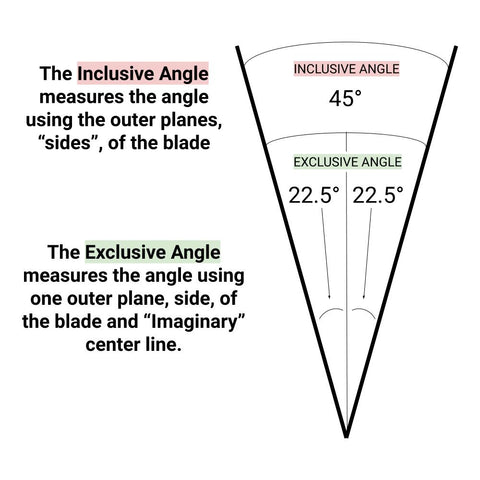Inclusive or Exclusive Sharpening Angles? Let's talk about it!

Exclusive or Inclusive Angle for Sharpening?
What am I even talking about?
Let’s start with some simple definitions for each of the terms.
EXCLUSIVE SHARPENING ANGLES a.k.a. Degrees per Side
First, Exclusive angles refer to the angle of one side of your knife’s blade. Another common name for this is Degrees Per Side. Exclusive Sharpening Angles are measured using the OUTER PLANE and the CENTER LINE (See Below). Since we sharpen knives one side at a time, Exclusive (Degrees Per Side) is the most common way to refer to angles when it comes to sharpening. We always refer to Exclusive Angles when discussing Sharpening on this blog or site. Our Popular Knife Sharpening Angle Guide measures the exclusive angle you wish to sharpen. In contrast, the F. Dick SM 111 has proprietary angle guides that are measured in Inclusive angles.
INCLUSIVE SHARPENING ANGLES
 Inclusive Angles are defined by the overall angle. Inclusive angles are measured with the two OUTER PLANES An inclusive angle, at its simplest is the sum of the two Exclusive angles. The issue with using an inclusive angle when sharpening is two fold, one must assume that each side of the knife’s blade is the same angle. Not all knives are sharpened like this. Many chisels and tools are single bevel, an Inclusive angle does an inadequate job of describing the sharpening process. Since one side is 0 degrees. The exclusive and inclusive angle will actually be the same. This is actually an interesting point of discussion. An inclusive angle assumes a center line from where the 2 planes meet, or the point of the edge. A chisel grind or single bevel blade’s planes do meet in the center. We highly recommend using Exclusive Angles or Degrees Per Side to describe your angles.
Inclusive Angles are defined by the overall angle. Inclusive angles are measured with the two OUTER PLANES An inclusive angle, at its simplest is the sum of the two Exclusive angles. The issue with using an inclusive angle when sharpening is two fold, one must assume that each side of the knife’s blade is the same angle. Not all knives are sharpened like this. Many chisels and tools are single bevel, an Inclusive angle does an inadequate job of describing the sharpening process. Since one side is 0 degrees. The exclusive and inclusive angle will actually be the same. This is actually an interesting point of discussion. An inclusive angle assumes a center line from where the 2 planes meet, or the point of the edge. A chisel grind or single bevel blade’s planes do meet in the center. We highly recommend using Exclusive Angles or Degrees Per Side to describe your angles.
How to tell the difference.
Generally inclusive angles begin around 25-30 degrees and go up from there. Very few knives are sharpened below 12.5 degrees. Most Japanese cutlery will be sharpened right around 15 Degrees Per Side, if the blade is single bevel, sometimes referred to as “chisel grind”. If you are uncertain if you're looking at an Inclusive or Exclusive Sharpening Angle, use your best judgement, generally one will make more a lot more sense than the other!
Thank you for reading, I hope you found this helpful!
Happy Sharpening,
Jesse C.
